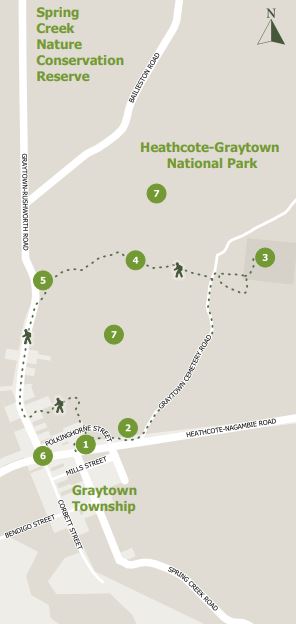Graytown - POW Camp, Gold Diggings and Cemetery Walk

This intriguing 3.5km history walk takes you through the Graytown WWII Prisoner of War Camp site into Heathcote-Graytown National Park and onto the Graytown Cemetery, then back via Graytown gold diggings to close the loop at the old township site.
Local History
Graytown was known as Spring Creek when gold was discovered in September 1868. Within a few months over 30,000 people had arrived. Shop keepers followed, tents and shanties made way for wooden structures. By June 1869, there were 216 beer premises, 36 butchers, 14 bakeries, 17 general stores, 5 banks, 4 chemists, 5 doctors, 2 newspapers, 5 soft drink manufacturers, 10 drapers, 8 restaurants, 6 tobacconists, 10 boot makers, 6 timber yards, 18 blacksmiths, 2 watch makers, 3 ironmongers, 2 tin smiths and 72 unknown stores, a Cobb & Co Station and 19 Police Officers.
Life was rough, illegal mining was a problem along with larrikanism. At its worst families had their children sleep on the floor to avoid stray revolver shots.
However, the diggings came to a sudden end in the winter of 1871. Flooding caused extensive damage and most miners lost everything. They moved on. Some hardened prospectors kept going into the early 1900s.
The cemetery was registered on June 3, 1870. Many were too poor to pay, resulting in unauthorised and unrecorded burials. There are many unmarked Chinese graves. The first burial was a 2 month old baby on June 21. Diarrhoea and mining related injuries were common causes of death.
Pressure to mine the area was so great it resulted in tunnelling under the fences and into the cemetery.
Eventually, the cemetery size had to be reduced as a result. As a consequence, graves exist outside of the cemetery.
During the Second World War a Prisoner of War Camp was established at Graytown (Camp 6). Approximately 250 Italian and then German POWs were detained. They were not released until January 1947. The German POWs were mostly crew members from the German raider ship "Kormoran" that sunk the HMAS Sydney off the West Australian coast in 1941. Some Finnish seamen were also held. The wreckages of the Sydney and Kormoran were not found until March 2008.
Each compound was enclosed by a double row of wire fencing 2 metres high with coiled barbed wire in between. Guard towers stood at each corner and the perimeter was lit at night.
About 20 Prisoners were held in each of the timber framed barracks. Kitchens, mess huts, shower blocks, laundries and latrines were all located within the compounds. Camps were divided to separate nationalities.
The surrounding forest has been cut for firewood since early settlement. POWs were engaged in unpaid work cutting firewood in the forest. Timber cutting continued until 2002 when the National Park was declared.
Foundations and wire are all that remain of the camp today.
Location
Corner of Polkinghorne St and Heathcote-Nagambie Rd, Graytown 3608. Walk through the Prisoner of War (POW) Camp, following the track below the main road to Graytown Cemetery Rd. When leaving the cemetery, take the track opposite the gate through the diggings. Turn left at Graytown-Rushworth Rd to head back toward the old township site and POW Camp.
Map of Walk Route

Points on map:
1. Graytown Prisoner of War Camp
2. Dirt track to Graytown Cemetery Rd
3. Graytown Cemetery
4. The Diggings
5. Grand Yellow Box tree
6. Site of Graytown Township.
7. A small corner of Heathcote-Graytown National Park
Interactive Map
Access for Dogs:
Dogs are not permitted.
Location
Cnr Polkinghorne Street and Heathcote-Nagambie Road, Graytown 3608 Map
Web Links
→ Walk Notes - POW Camp, Gold Diggings and Cemetery Walk (PDF)
→ POW Camp, Gold Diggings and Cemetery Walk, Graytown (Walking Maps)











